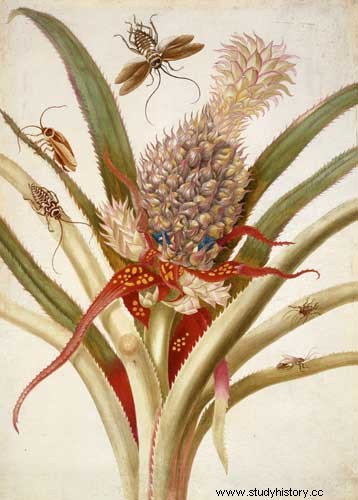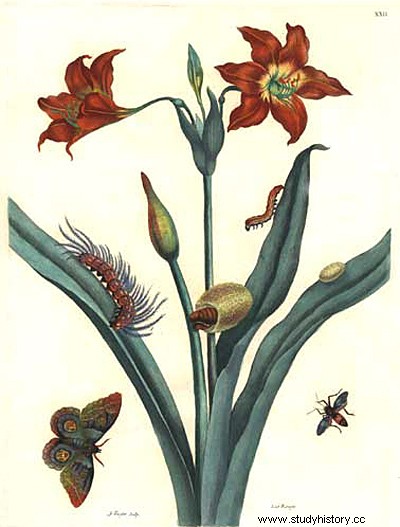Naturalist and designer, Maria Sibylla Merian (1647 – 1717) delivered, through his very detailed observations and reproductions, considerable scientific work, particularly on the metamorphosis of butterflies.
Apprentice painter
 Daughter of Johanna Sybilla Heim and Matthäus Merian, Anna Maria Sibylla Merian (born April 2, 1647 in Frankfurt- on-the-Main in Germany) only knew his father during his first three years; Matthäus died after a long illness in 1650. Johanna quickly remarried to Jacob Marell, an engraver and painter specializing in the painting of flowers.
Daughter of Johanna Sybilla Heim and Matthäus Merian, Anna Maria Sibylla Merian (born April 2, 1647 in Frankfurt- on-the-Main in Germany) only knew his father during his first three years; Matthäus died after a long illness in 1650. Johanna quickly remarried to Jacob Marell, an engraver and painter specializing in the painting of flowers.
Jacob took on apprentices and, when she was thirteen, Maria joined his class. Talented, she quickly began to create paintings based on observations of nature, first of silkworms, then of butterflies and plants.
The metamorphosis of butterflies
 At the age of 18, Maria Sibylla Merian married Johann Andreas Graff, a pupil of her stepfather who specialized in painting architecture, with whom she settled in Nuremberg. Their daughter, Johanna Helena, was born two years later.
At the age of 18, Maria Sibylla Merian married Johann Andreas Graff, a pupil of her stepfather who specialized in painting architecture, with whom she settled in Nuremberg. Their daughter, Johanna Helena, was born two years later.
Maria embarks more attentively on the study of the life cycle and the metamorphosis of butterflies; it describes and represents the caterpillars, the chrysalises, the adult specimens. At the same time, she is interested in the plants they feed on and the parasites of the cocoons, and makes many detailed sketches.
In 1675, Maria published her first work, entitled New Book of Flowers (Neues Blumenbuch). Dedicated to botany, the book focuses on the description of plants and flowers in which she became interested by studying the life cycle of butterflies. After the birth of her second daughter, Dorotha Maria, she published the book The Caterpillar, Wonderful Transformation and Strange Flower Food (Der Raupen wunderbare Verwandlung und sonderbare Blumennahrung).
Independence
In 1685 Maria Sibylla Merian left her husband and took her two daughters to live with her in a Protestant community at Waltha Castle in West Friesland. She will spend a few years there, while continuing her work on the caterpillars. In 1690, she asked for a divorce. From the following year, she declared herself a widow although her husband was still alive.
In 1692, the community of Waltha was dissolved and Maria left to live with her daughters in Amsterdam. There, she embarked on the transmission of knowledge and taught in particular to Rachel Ruysch, who would become a painter in her turn. She earns her living by making illustrations and embarks on the collection of natural specimens, in particular insects and shells. These collections were then very fashionable in the Netherlands, and Maria frequented other collectors.
Excursion to Suriname
Through her collections, Maria Sibylla Merian discovers and takes an interest in the butterflies of Suriname. In July 1699, she decided to go on a trip there with her daughter Dorothea to study the tropical fauna and flora. Although her connections try to dissuade her, Maria obtains a scholarship and sells her collections to finance her trip.
After two months of travel, Maria and her daughter reach Surimane and make several excursions in the country, accompanied by Native American slaves who assist them in their work. Maria makes many drawings of the local flora and is particularly interested in the metamorphosis of the insects encountered.
Metamorphosis insectorum Surinamensium
During her trip, Maria Sibylla Merian contracts malaria and falls seriously ill. Forced to return to the Netherlands, she takes a vast collection of insects collected there. It will take him three years of work, around his drawings and sketches, to complete his important work on the fauna and flora of Suriname:Metamorphoses of Suriname insects (Metamorphosis insectorum Surinamensium).
Maria spares no expense to ensure her work is of the highest possible quality. On this subject, she explains:
“I had the plates engraved by a famous master, and at the same time I brought the best paper, to bring joy and fun not only to art lovers but also to insect lovers. »
Given the work and the expenses incurred, Maria does not receive any money for this work. She earns her living through the sale of paintings and the lessons she continues to provide.
A great naturalist and artist
In 1715, Maria Sibylla Merian suffered a stroke which confined her to an armchair. She died two years later, in January 1717, at the age of 70. Already considered a great naturalist and artist in her time, Maria is increasingly recognized for her considerable work, both artistic and scientific. Banknotes, stamps are made with his effigy, many schools bear his name and species have been named in his honor.
Gallery
 Amazing Rare Things:The Art of Natural History in the Age of Discovery The Queen's Gallery, Palace of Holyroodhouse 2 March – 16 September 2007 Maria Sibylla Merian (1647-1717) Water hyacinth, tree-frogs and giant water bugs, c.1701-05 Credit line:The Royal Collection © 2006, Her Majesty Queen Elizabeth II This photograph is issued to end -user media only. It may be used ONCE only and ONLY to preview or review the exhibition “Amazing Rare Things:The Art of Natural History in the Age of Discovery”. Photographs must not be archived or sold on. Contact:Public Relations and Marketing, the Royal Collection 020 7839 1377
Amazing Rare Things:The Art of Natural History in the Age of Discovery The Queen's Gallery, Palace of Holyroodhouse 2 March – 16 September 2007 Maria Sibylla Merian (1647-1717) Water hyacinth, tree-frogs and giant water bugs, c.1701-05 Credit line:The Royal Collection © 2006, Her Majesty Queen Elizabeth II This photograph is issued to end -user media only. It may be used ONCE only and ONLY to preview or review the exhibition “Amazing Rare Things:The Art of Natural History in the Age of Discovery”. Photographs must not be archived or sold on. Contact:Public Relations and Marketing, the Royal Collection 020 7839 1377  Amazing Rare Things:The Art of Natural History in the Age of Discovery The Queen's Gallery, Palace of Holyroodhouse 2 March – 16 September 2007 Maria Sibylla Merian (1647-1717) Pineapple with cockroache, c.1701-05 Credit line:The Royal Collection © 2006, Her Majesty Queen Elizabeth II This photograph is issued to end-user media only. It may be used ONCE only and ONLY to preview or review the exhibition “Amazing Rare Things:The Art of Natural History in the Age of Discovery”. Photographs must not be archived or sold on. Contact:Public Relations and Marketing, the Royal Collection 020 7839 1377
Amazing Rare Things:The Art of Natural History in the Age of Discovery The Queen's Gallery, Palace of Holyroodhouse 2 March – 16 September 2007 Maria Sibylla Merian (1647-1717) Pineapple with cockroache, c.1701-05 Credit line:The Royal Collection © 2006, Her Majesty Queen Elizabeth II This photograph is issued to end-user media only. It may be used ONCE only and ONLY to preview or review the exhibition “Amazing Rare Things:The Art of Natural History in the Age of Discovery”. Photographs must not be archived or sold on. Contact:Public Relations and Marketing, the Royal Collection 020 7839 1377  Amazing Rare Things:The Art of Natural History in the Age of Discovery The Queen's Gallery, Palace of Holyroodhouse 2 March – 16 September 2007 Maria Sibylla Merian (1647-1717) Common or ‘spectacled’ caiman and South American false coral snake, c.1705-10 Credit line:The Royal Collection © 2006, Her Majesty Queen Elizabeth II This photograph is issued to end-user media only. It may be used ONCE only and ONLY to preview or review the exhibition “Amazing Rare Things:The Art of Natural History in the Age of Discovery”. Photographs must not be archived or sold on. Contact:Public Relations and Marketing, the Royal Collection 020 7839 1377
Amazing Rare Things:The Art of Natural History in the Age of Discovery The Queen's Gallery, Palace of Holyroodhouse 2 March – 16 September 2007 Maria Sibylla Merian (1647-1717) Common or ‘spectacled’ caiman and South American false coral snake, c.1705-10 Credit line:The Royal Collection © 2006, Her Majesty Queen Elizabeth II This photograph is issued to end-user media only. It may be used ONCE only and ONLY to preview or review the exhibition “Amazing Rare Things:The Art of Natural History in the Age of Discovery”. Photographs must not be archived or sold on. Contact:Public Relations and Marketing, the Royal Collection 020 7839 1377 


